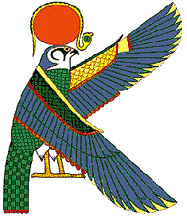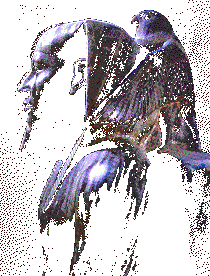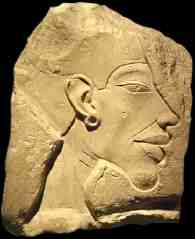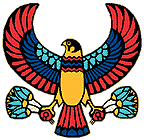


Ancient Egypt, the fabled land of the pharaohs, has fascinated many
historians and archaeologists. This ancient civilization has a
distinctive culture with motifs familiar to most of the western
world today, and still captures the imagination more readily than
many other cultures of its time. This is largely due to the
Egyptian style of art: colorful, consistent, monumental,
and mathematical. The
pyramids
at Giza or the Sphinx
are instantly recognized throughout the world, and these
works in particular show a constant theme in Egyptian
art: the reflection of the culture's metaphysical beliefs
and mythology. The religious beliefs of Egyptians varied among
different areas of the two kingdoms, and it would be impossible
to explain every local variation of every myth here. The art
of the civilization, however, seems at first to have an
extremely consistant style throughout history, but upon closer
inspection we see subtle nuances of evolution in Egyptian art
from the Predynastic period to the New Kingdom and afterwards.
 |
Egyptian art was influenced by several factors, including the Nile River, the two kingdoms (the Upper in the south and the Lower in the north), agriculture and hunting, animals, the heavens, the pharaohs and gods, and religious beliefs. Religion was one of the major patrons of Egyptian art throughout its three-millenium history. It was a major part of daily life, and so eventually evolved into such a complexity that it could take books to explain each symbol and categorize each deity. Even the current king was considered a deity, and after his death he became like Osiris, the god who died and was reborn (a common mythological archetype), and lived in the underworld with the gods. Most art found in tombs featured either the pharaoh or the gods as subject, whether painting or sculpture, and made generous use of symbols to convey different layers of meaning. The symbols so apparent in Egyptian mythology could be used to either hide or reveal a message, conveyed by hieroglyphs, the ideographic written language system, or by the artwork itself, to an audience. |
| Sculpture is the most common example of Egyptian art that we have today, and specimens exist that date to the Predynastic period. Most of these are pottery and figurines, but these already show expressionistic qualities in the painting of the pottery, and many clay figures even represent local gods. In the Old Kingdom ( roughly 2700-2100 B.C.), sculpture mainly represented the royal family members. They were portrayed in a very solid, symmetrical, blocklike fashion. The monumental Great Sphinx at Giza, constructed for Khafre (a 4th dynasty pharaoh), clearly shows this style. A portrait of the king is placed upon the body of a lion or panther, which shows his connection with the heavens, as the skies were represented earlier by a panther (Nut, the sky goddess, is shown arched over the heavens on all fours like her animal predecessor). Another deity that is shown often is Horus, the falcon god, who is seen protecting the head of Khafre in his life-size portrait. Most of these portrait statues were found in the tombs of the kings, as they were to provide a place for the king's ka, or soul, after his death. |  |
During the Middle Kingdom (about 2000-1650 B.C.), paintings and occasional
relief sculpture were found on the walls of royal tombs, which were often
large rooms carved out of the sides of cliffs. Many of these depict scenes
from daily life as well as those of the afterlife. The exacting details
of Egyptian painting were responsible for the regularity of the subjects.
Objects were drawn at their most characteristic angle, and specific canons of
proportion were used for figures. For both painting and relief carving,
sketches were drawn over a graph on the surface and had to be approved by a
trained designer before work could begin. Small crafted objects
found in tombs include faience (a glass paste used as a glaze)
animal figurines and intricate
jewelry made from gold and precious stones. Larger sculptures found
from this era do not have the same rigidity of the Old Kingdom, but
are more realistic and reflect some of the personality of the
subject.
 |
In the New Kingdom (circa 1550-1100 B.C.), many new palaces and courts were built along the Nile. Worship of the god Amun had become widespread, and it was with this deity that the pharaoh identified himself. When Amenhotep IV came to the throne in the 18th Dynasty, he managed to completely reform Egypt's religious, artistic, and political ideas by establishing what Egyptologists now believe was the first monotheistic religion- worship of Aten the solar disk as supreme being. He also changed his own name to Akhenaten ("on the behalf of Aten") and saw himself as the literal son of the sun. According to his commands, court artists' depictions of the pharaoh placed him in informal settings, often with his family. He is portrayed with distinctively odd features; this is often thought to be due to the realism he advocated in New Kingdom art. Most Egyptologists believe that the artists portrayed him with disfigurements due to royal inbreeding. However, another view suggests that his distorted form is actually a merging of female and male characteristics. The sun embodied both male and female aspects, and as representative of the sun on earth, artists portrayed Akhenaten as such. |
One type of treasure from the New Kingdom that represents painting
from that period is the Pert-em-Hru ("Coming Forth by Day"), also
known as the Book of the Dead. This was like a guide to the
underworld for the deceased, and a personal copy was included in many
tombs. The Egyptian myths of the afterlife are evident in the spells and
incantations that the deceased must recite to help him pass judgement:
after death,
the person's heart was weighed against the feather of Truth,
and which way the balance fell determined whether the
person was worthy to enter the underworld and live with Osiris. The heart
and the feather were placed upon a balance and weighed by
Thoth, who recorded
the results. Those who were pure and "true of voice" were escorted by Horus
into the underworld, where they lived in peace for ever. Those whose heart
was heavier than the feather of Truth were destroyed by a monster known as
Ammut, who was part crocodile, part lioness, and part hippopotamus. The
most well-known example of these is the Scroll of Ani, painted on papyrus
during the New Kingdom.


© 1999 ele+@andrew.cmu.edu